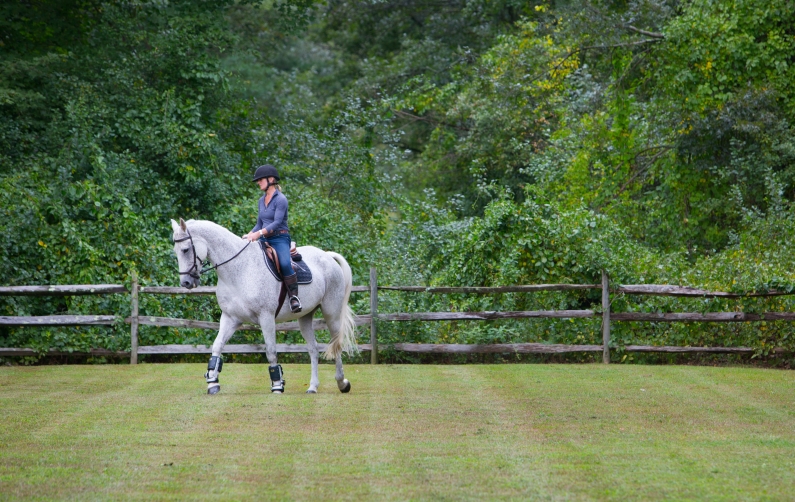
So your horse was cleared to begin the tack walking process….woo woo! You can’t wait to swing your leg over that saddle again and get the process started. However, that thrill quickly can wear off as we’re tempted to do too much or too little and suddenly a half hour tack walk seems like eternity. You are not alone. Rehab is a rollercoaster. But to be honest, rehab can take your relationship with your horse to a whole new level. You are forced to go back to the basics, to be aware of each and every step, and to nail that walk! First off, I’m not a vet so please please ALWAYS refer to your vet for any questions or ideas for you and your horses’ rehab. But here are some tips, tricks and suggestions to help make the most out of your tack walking time with you horse.
Your tack walk schedule should be discussed with your vet and trainer so your “home team” is all on the same page. Be sure that your horse is properly shod or trimmed when you are tack walking to avoid tripping or further injury. Most of the time if you are tack walking, this means you should be on smooth, level surfaces. Check with your vet on type of footing that you should be tack walking in. Once you have the how, where, when covered it’s time to start your tack walking journey. I recommend keeping a log, so you know how long you walked for, anything you worked on during the ride, or anything that felt funky or different.
PACE: I always see riders either get on and want to do too much- leg yielding about, pushing them into the corners, too small of figures, etc. OR riders just hacking about in a tortoise walk. (Again, if your vet is telling you to do either of these items then by all means go for it). Neither of these walks are going to help you score a 10 on your next medium walk in your dressage test so don’t practice this type of walk! Practice a walk you can “do something” with. By that I mean a walk you can halt from or one you *could* trot from if you were allowed. Hold your walk to a higher standard and remember it should be a working gait not just a meander about.
WALK-HALTS: Such a simple transition but there’s so much more to it than you think. Can you halt by just thinking it or whispering with your aids? What about your walk transition? Get so in tune with your horse that you can just stretch up and sit still and then stand underneath you. Now how was your halt? Is it straight and square? How was your walk transition? Did they march right off? Did they get inverted or crooked? Practice the transitions you want and all the sudden you’ll feel like your horse is a mind reader!
FREE WALK: I don’t know about you, but my free walk is typically one of the worst parts of my dressage test. I could blame it on typically riding hopped up, fit TB’s who would prefer running and jumping but regardless what a great time to work on perfecting that free walk. Do them all around the arena, not just across the diagonals. Can you free walk 15 steps then medium walk 15 steps? What about on a circle or serpentine? Practicing the pick up and soften down will be a good test on if your horse is working through and over their back as well as improve the quality of the walk as you go.
SHORTEN AND LENGTHEN: Pick two letters in your arena-maybe down the long sides. Count how many medium walk steps you do and see if you can be that accurate each time you go down that side. Now can you add a step, two steps, three steps? What about can you lengthen the step without trotting off? This will help your horse come off your seat and make your horse adjustable like an accordion as you go. Mixing up the walks will help keep their attention, so you don’t just walk around and around the arena.
FIGURES: If you’re tacking walking, I am going to assume you shouldn’t be making small turns or really pushing deep into the corners. That doesn’t mean you can’t perfect larger figures. Get to know the geometry of the arena like the back of your hand. How perfect can your 20 meter circles be? How about center lines and diagonals? Add in serpentines or broken lines to work on changing the bend without making small turns. You can add in halt transitions, free walks, or adjustability into the figures to increase the difficulty.
POLES: Only add in poles once your vet gives you the green light BUT when you can, your options are endless. Google any pole or jump exercise-all of these can be done at walk with ground poles. You will find straightness exercises, consistency exercises, adjustability exercises, and so on and so forth. This is a great way to work on your straightness and keep your horse’s attention.
MIX IT UP: If you are allowed (and your horse keeps their brain in their ears), mix up where you are riding. I am fortunate to have an indoor, outdoor, derby field, and hacking space that all have good weather and are level and even. I mix up where I’m riding so my rehab horses aren’t just carouselling around and around the indoor.
MUSIC: I prefer to tack walk to music. This helps time pass, I mix up what I’m doing as different songs come on, and it helps distract us a bit rather than being too relaxed or too on edge as we are tack walking our horses. I think my horses appreciate it too.

